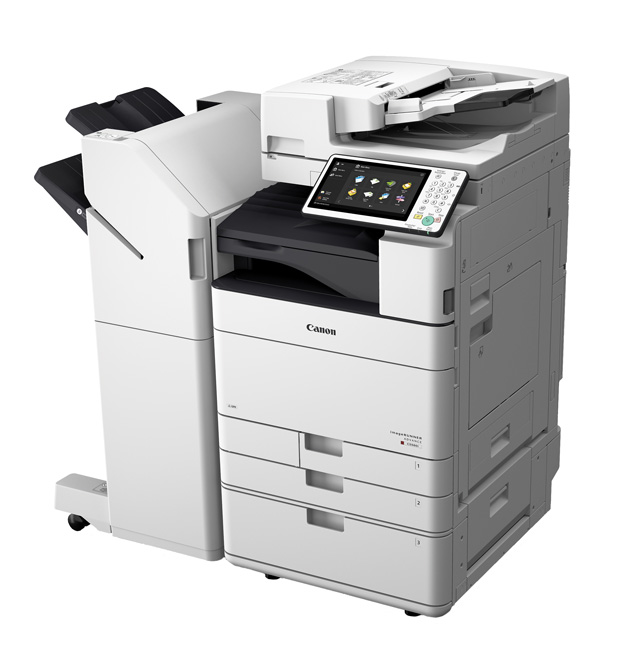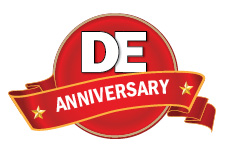
Canon Solutions America’s imageRUNNER ADVANCE C5560i multifunction color system, shown here with the External Finisher. Image courtesy of Canon Solutions America.
Latest News
September 1, 2016
 Canon Solutions America’s imageRUNNER ADVANCE C5560i multifunction color system, shown here with the External Finisher. Image courtesy of Canon Solutions America.
Canon Solutions America’s imageRUNNER ADVANCE C5560i multifunction color system, shown here with the External Finisher. Image courtesy of Canon Solutions America.Mitsubishi Mahindra Agricultural Machinery Co. Ltd., like many innovative technology companies, seeks to expedite its design practices. They want the best practices to create effective designs with speed and flexibility. This warrants best practices along with tools and technology that offer the ability to wirelessly print from mobile devices.
In Mitsubishi’s case, they practice concurrent engineering, which entails designing products as you build them. As they do so, they need to incorporate changes from the field. Moving the design process from the desk to anywhere demands capabilities that are not as critical when working at the office—including the ability to print designs from mobile devices.
For engineers, it’s a necessary capability that allows for their designs to be analyzed, discussed, submitted and revised. For print device manufacturers, it means developing software and devices to meet the demand presented by engineers on the go who use mobile devices to complete their work.
Engineers On The Go
Mobile engineers are loading their devices with 3D modeling software that draws from offsite data repositories. They are now doing this with tablets, smartphones and sometimes switch between a mobile device and desktop workstation. Because they’re used to plotting views, the capability to print from their mobile device is key. An ability to print an assembly view or a “what if” component greatly enhances the ability to communicate designs quickly.
“Engineering professionals have increasingly collaborative and mobile work requirements and as such need to share, view and print large format documents from a variety of locations using mobile devices like the Apple iPad, iPhone and other tablet devices,” says Bob Honn, director of Marketing Support at Canon Solutions America. “Mobile print applications make this collaborative approach easier by leveraging the mobile device’s internet connection in conjunction with third-party software to access and print to large-format enabled printers. By doing so, mobile professionals can share, manage and print content.”
An Emerging Market for Wireless Printing
According to the research firm IDC, 35% of smartphone users and 34% of tablet users want to print, but don’t know how. Printing has traditionally been conducted from a desktop at the home office. IDC says mobile printing will grow dramatically within the next two years due to an overall increase in access to digital content. This influx of demand seems to be fueling an emerging market for wireless printing.
The research firm Technavio confirms this trend and says demand for wireless printing over the next few years will be catalyzed by the bring-your-own-device (BYOD) culture within the workforce. According to Technavio, about 34% of the global workforce is mobile. This demand is fueling the global wireless printer market, which is predicted to reach $73 billion by 2019.
This is particularly true for engineers who can develop sub-assembly designs on a tablet and include details right down to the thread count on a fastener. They can bring the tablet to a client meeting and fire off a print at the client’s facility to leave them with several dimensional views for final approval.
“By deploying wireless technology to share files, printing service providers are offering managed print services to companies through outsourced third-party vendor arrangements,” says Navin Rajendra, lead market research analyst for Hardware and Semiconductor Research at Technavio. “It not only saves 30% of the total cost of printing but also provides better integrated and secured document solutions. As per the key findings of this market forecast, the growing popularity of wireless docking stations among electronics consumers will augment wireless printer sales during the forecast period. This market analysis also indicates a decline in prices of wireless docking devices over the next four years as technology improves.”
Such a trend makes way to a host of solutions from many print device manufacturers: Devices and software that are small and mighty with many specialized features.
From Cloud Repository To Print Device
Brother Mobile Solutions, Inc. (BMS), which offers mobile wireless printing solutions, is a wholly-owned subsidiary of Brother International Corporation. The company recently launched its PocketJet 7 mobile printer, a full-page mobile printing solution. With mobile devices, designers are using hybrid IT: A combination of the traditional desktop, a mobile device and cloud computing.
Xerox is developing useful tools for mobile devices and multifunction printers as well. Several of its tools will make it easier for remote workers to use the same workflows they would in an office—even though they’re working remotely. Workers can securely send documents from their mobile device to colleagues or the cloud, as well as print to just about any printer.
“Working on the go often brings unneeded complexity and workflow jams like when you can’t connect to a local printer or your company’s cloud repositories,” says Jim Rise, senior VP, Office and Solutions Business Group at Xerox.
Flexibility for Any Time, Anywhere
Brückner, a company that specializes in film stretching technology, relies on a cloud repository of digital data. One of their plants manufactures special machinery for the processing of plastic film. The company has used Siemens PLM Software’s Solid Edge 3D/2D CAD software system, often on tablets.
At least 100 of the 600 or so Brückner employees work with Solid Edge—not only in development, engineering and design, but also in technical sales, marketing and documentation. On release of the Solid Edge drawings, an automatic conversion into the TIFF format is initiated. This allows drawings for manufacture and assembly to be sent to an individual server and on to an intelligent plot management system PLOSSYS, from SEAL Systems, to produce a supply of drawing printouts for production.
Clayco Engineering also actively embraces design collaboration using tablets and the cloud for its construction engineering work. The company uses Autodesk BIM 360 with tablets at the point of construction. Field staff use tablets to access project-management workflows, such as quality assurance, quality control, commissioning, issue creation and sign-off, job tracking and safety, as well as a project-based document library.
Field teams turn to iPads to complete checklists at the job site, add digital photos to markup observations, and share that data with the entire project team. All actionable items are tracked in one database that everyone uses to eliminate data silos.
With the advent of printing technology for mobile devices, engineers are better able to take advantage of all cloud-based data depositories from anywhere. It makes today’s design engineer more nimble and flexible. They have more options to draw from data in the cloud, design and fabricate concurrently if they desire, and be more efficient and effective in their design practice.
Canon’s Honn says flexibility is driving printing technology for today’s mobile engineering designer. Flexibility is key: print the latest product design update from anywhere.
More Info
Subscribe to our FREE magazine, FREE email newsletters or both!
Latest News
About the Author
Jim Romeo is a freelance writer based in Chesapeake, VA. Send e-mail about this article to [email protected].
Follow DE






